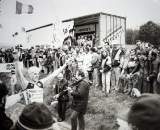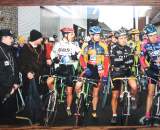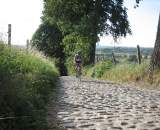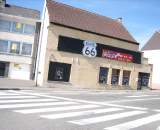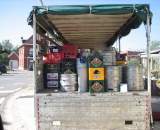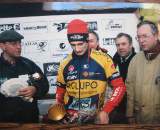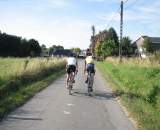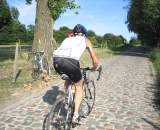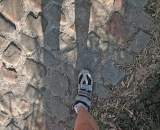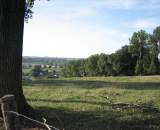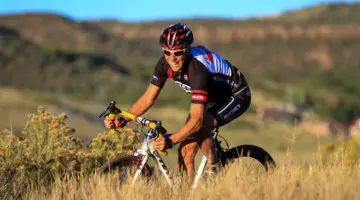by Christine Vardaros, with help from Luc Lamon and his son Simon – two key event organizers
EVENT BACKGROUND
A two-wheeled show like no other, Koppenbergcross is a mystical experience for riders and spectators alike. Everyone walks away from it feeling the excitement of taking part in the making of history. As the most famous of all cyclocross events, its spectatorship is topped only by World Championships. The event’s fame stems from its inclusion of the legendary Koppenberg climb used in Tour of Flanders, the Spring Classics road race. The climb is located in the East Flanders region of Belgium, in a town called Oudenaarde, near the Tour of Flanders Museum.
Covered in rough cobbles, the climb is just over .5 kilometers in length and rises 74 meters, hitting 22% gradient in parts. Due to its difficulty, it has played an integral role in the outcome of many Tour de Flanders races, especially on rainy days where the cobbles turn to grease forcing many riders to ascend it cyclocross style. In as recently as the 2006 edition of Tour of Flanders, only the first eight riders made it up the climb rubber side down. Even with its recent restorations, it is still a climb that is truly feared yet respected.
I recently had a chance to interview two key Koppenbergcross event organizers, Luc Lamon and his son, 23 year old Simon, at their home a couple of towns away from the legendary event. Luc handles public relations such as securing sponsors, handling VIP arrangements, and spreading the word about the race. Simon is Secretary of the event, dealing with practical and organizational tasks.
HISTORY
Koppenbergcross held its first event in 1988. In the beginning it wasn’t nearly the big fiesta as it is now. There were surely no beer tents or hamburger trailers scattered about. It was a slow progression, considered a local-only event straight through to the mid-90’s.
During its solitary hiatus between 1992 to 1995, the event was revamped, but even in their comeback year they only had 12 riders and 100 spectators – no rider contracts back then. It wasn’t until Luc came on board in 1997 that the race started to take off. As a sports journalist for Gazette van Antwerpen (GVA), he was able to use his contacts to get the big teams to the event. He also attracted the up-and-comers of that time. “We didn’t have much money in the beginning. We began with the young guys like [Bart] Wellens and [Sven] Nys. Koppenberg was their first big race, and it was the first big win for Wellens was Koppenberg,” Luc explained. “Our event is so great now because of all these young guys like Wellens and Nys. We became great together.” Nowadays, they regularly get 15-20,000 spectators, 13,000 with heavy rains.
But as any organizer can tell you, Mother Nature can sometimes interfere with a good thing, and this happened to Koppenbergcross’ in 2000. “Due to terrible weather, the media told people to stay inside if they don’t have to be outdoors. The course was all mud. Except for two to three hundred meters, the riders had to run the whole course. Before the event, Danny De Bie [Team Leader of Fidea] asked me how many people we expect to have…to watch that much running,” said Luc. Only 3,000 spectators showed.
Minor setbacks aside, their sights were on the next step in their growth. In 2002, they became part of the GVA Trofee series and added a women’s category. What ensued from their partnership with GVA was regular television coverage of the event. Once on TV, its popularity spiked.
PREPARATION
As a racer of the event, all I see is the finished product – those few hours of a well-organized blowout event. It would never occur to me that it takes almost a full year of preparation to put it together. According to Simon, “Preparation for the next Koppenbergcross starts with one month of cleaning the course from the previous race. Then we immediately do an evaluation and it’s prep time.”
The hardest part of organizing their event is to foresee problems. They use an extensive dateline to keep on target for their deadlines and to make sure nothing is overlooked. The third week before the event is when the real pressure comes since all the prep work has to be completed by their hard deadline of two weeks before race day. With an event of this caliber, there is an almost insurmountable list of chores to be done. In the last two weeks, they make an average of 1000 calls and receive nearly 2000 emails per day. Even a simple date change like this year’s calendar move from November 1st to October 25th is a major project.
BUDGET
Every year, Koppenbergcross needs to raise 150-200,000€ in cash and product in order to break even. They make their money mainly from sponsors, alcohol sales and entry fees. But just because their event is famous, doesn’t mean sponsorship comes easy. According to Luc, it takes work to find sponsors for even the smallest amounts like 2,500 or 5,000€. This is in stark contrast to the effort it takes him to find money for his post-tour criterium which is still more popular than cyclocross events. To keep their sponsors coming back and to entice new ones, Luc puts a lot of effort into VIP treatment for their sponsors. They set up a VIP tent on site with the booze flowing and take them all to dinner that evening.
Luckily, when the race doesn’t bring in the big bucks or sustains a major loss due to extreme weather, they have support in the form of event organizing company Golazo, who is the financial backer for all GVA races. This definitely helps the event’s sustainability considering a loss of even a thousand spectators has a major impact. But on the flipside, if the event strikes gold, Golazo also takes the financial glory as the Koppenbergcross organization called De Sint-Pietersvrienden is non-profit. Aside from the one head guy who gets paid for half-time work, all thirteen staff members work for free. With no money to be had, they still manage to regularly get 500 volunteers for race day.
COURSE SETUP
Office work is only half the battle. The other half is the actual construction of the course. According to Simon, “It takes three weeks in advance to start building on location. First we get all the cows off the field.” As the course is built on a steep hill, setup is a real bitch. “We’ve had many almost-disasters like cars from our crew going down the hill without being able to brake on the wet cobbles. One car almost hit an electricity pole. Another time, two Czech guys attempted to get their money by car at the top of the climb. Key word was ‘attempted'”, joked Simon.
Safety is also a concern with course design. As a racer, I had a tough time imagining this, considering how treacherous that descent is – especially when wet. But Luc assured me that they do try to make the race a little safer on the most dangerous curves. He said, “We make the turn wider, with a fence between the rider and spectators so the rider doesn’t fall into the spectators.”
I gasped. So it is the spectators whom they protect! He chuckled, and responded matter-of-factly, “The fence also protects the riders by keeping the spectators far enough away that they can’t lean over the fence and hurt the riders. And riders usually slide so they don’t get hurt; but for the spectators it is more dangerous.” Good point.
When it comes to weather on race day, “All the spectators cry for a muddy course,” said Luc. But from a race organizer’s perspective, he added, “It is hard to work in mud and spectatorship drops. Clean up is bad. The police must close the roads for ten days after the race for cleanup.”
RACE DAY
Entry tickets for Koppenbergcross are 10€, which is average for a cross race. To alleviate race-day rush at the gates, their tickets are sold in advance for 9€ at about twenty locations in Belgium, most are smoke-filled cafes.
As for the staff, when asked how it feels to sit back and relax while watching their project come to life, Simon responded, “We all work the whole day so we get to see it afterwards on video.”
With thousands of folks running around, Koppenbergcross can be chaotic. Naturally there will always be a few who try to illegally benefit from its large crowds. “You hear about a guy from a bar down the block who is going to set something up on site, a butcher who bought 200-300 kilos of beef and plans to do a barbeque at the course,” said Luc. He went into detail about one such incident, “Every year, we have a contract with a guy who does fries. One year, a fries guy shows up but I didn’t recognize the car. It turns out he was selling for a woman at the bar down the block. When I asked her why she was there, she said, “I think the guy who gave me permission is Luc Lamon.” I handed her my passport and she had nothing to say.”
WHY ATTEND?
This event has a special significance to the riders as it usually the first hard race of the season. It is the first time they can see the difference in their season preparation since the races leading up to this one are traditionally “road-style” courses where road tactics can play as large a factor as fitness. “There is a lot of hope early in the season,” said Luc. From an organizer’s perspective, Luc added, “After Koppenberg, the filled buses are decided.” When a rider isn’t going well, it becomes more difficult to fill their buses as the season progresses, which lowers a racer’s value for event organizers.
The spectators come mainly for the spectacles such as last year’s final lap fall of Nys and Boom. Luc also credited their kids’ races for bringing in the spectators. They usually have over 100 kids per youth category. Simon had a slightly different take on the spectator draw. “Alcohol makes a big difference. It’s part of the festivities. A lot of people come for the drinking and a little bit of the cyclocross. Many go home and don’t even know who won the race,” explained Simon.
WHY?
When asked for final thoughts on Koppenbergcross, Simon quipped, “I can’t understand how they get 20,000 people when I think about is all the problems that go on behind the scenes.”
My response was, “Then why do it for free?” Luc grinned and said, “Some people have to be foolish.”
The 2009 edition is to be held on Sunday, October 25. Sven Nys will surely be there to defend his title. Having won it the last five years, he is considered King of Koppenbergcross. Defending the women’s title is Daphny Van den Brand. Having won it two of the four years they’ve had a women’s event, Van den Brand is considered its Queen.
This year holds a special surprise for the women. For the first time, they will compete on the same lap as the men, to include the infamous cobbled climb. Wish me luck.
Photo Gallery:
Past Winners:
| Year | Men’s winner | Women’s winner |
| 2008 | Sven Nys | |
| 2007 | Sven Nys | Daphny van den Brand |
| 2006 | Sven Nys | Marianne Vos |
| 2005 | Sven Nys | Daphny van den Brand |
| 2004 | Sven Nys | not held |
| 2003 | Bart Wellens | not held |
| 2002 | Richard Groenendaal | Laurence Leboucher |
| 2001 | Sven Nys | not held |
| 2000 | Mario De Clercq | not held |
| 1999 | Mario De Clercq | not held |
| 1998 | Peter Van Den Abeele | not held |
| 1997 | Bart Wellens | not held |
| 1996 | Peter Van Den Abeele | not held |
| 1995 | Mario Lammens | not held |
| 1992 | Pavel Camrda | not held |
| 1991 | Peter Van Den Abeele | not held |
| 1990 | Chris David | not held |
| 1989 | Rudy Thielemans | not held |
| 1988 | Rudy Thielemans | not held |












